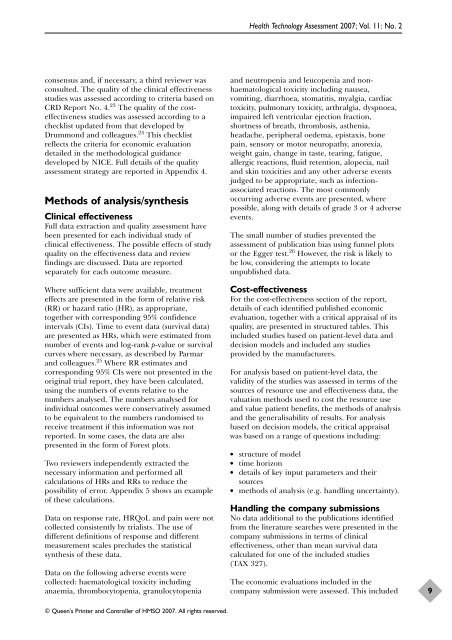Docetaxel with prednisone or prednisolone for the treatment of ...
Docetaxel with prednisone or prednisolone for the treatment of ...
Docetaxel with prednisone or prednisolone for the treatment of ...
Create successful ePaper yourself
Turn your PDF publications into a flip-book with our unique Google optimized e-Paper software.
consensus and, if necessary, a third reviewer was<br />
consulted. The quality <strong>of</strong> <strong>the</strong> clinical effectiveness<br />
studies was assessed acc<strong>or</strong>ding to criteria based on<br />
CRD Rep<strong>or</strong>t No. 4. 23 The quality <strong>of</strong> <strong>the</strong> costeffectiveness<br />
studies was assessed acc<strong>or</strong>ding to a<br />
checklist updated from that developed by<br />
Drummond and colleagues. 24 This checklist<br />
reflects <strong>the</strong> criteria f<strong>or</strong> economic evaluation<br />
detailed in <strong>the</strong> methodological guidance<br />
developed by NICE. Full details <strong>of</strong> <strong>the</strong> quality<br />
assessment strategy are rep<strong>or</strong>ted in Appendix 4.<br />
Methods <strong>of</strong> analysis/syn<strong>the</strong>sis<br />
Clinical effectiveness<br />
Full data extraction and quality assessment have<br />
been presented f<strong>or</strong> each individual study <strong>of</strong><br />
clinical effectiveness. The possible effects <strong>of</strong> study<br />
quality on <strong>the</strong> effectiveness data and review<br />
findings are discussed. Data are rep<strong>or</strong>ted<br />
separately f<strong>or</strong> each outcome measure.<br />
Where sufficient data were available, <strong>treatment</strong><br />
effects are presented in <strong>the</strong> f<strong>or</strong>m <strong>of</strong> relative risk<br />
(RR) <strong>or</strong> hazard ratio (HR), as appropriate,<br />
toge<strong>the</strong>r <strong>with</strong> c<strong>or</strong>responding 95% confidence<br />
intervals (CIs). Time to event data (survival data)<br />
are presented as HRs, which were estimated from<br />
number <strong>of</strong> events and log-rank p-value <strong>or</strong> survival<br />
curves where necessary, as described by Parmar<br />
and colleagues. 25 Where RR estimates and<br />
c<strong>or</strong>responding 95% CIs were not presented in <strong>the</strong><br />
<strong>or</strong>iginal trial rep<strong>or</strong>t, <strong>the</strong>y have been calculated,<br />
using <strong>the</strong> numbers <strong>of</strong> events relative to <strong>the</strong><br />
numbers analysed. The numbers analysed f<strong>or</strong><br />
individual outcomes were conservatively assumed<br />
to be equivalent to <strong>the</strong> numbers randomised to<br />
receive <strong>treatment</strong> if this inf<strong>or</strong>mation was not<br />
rep<strong>or</strong>ted. In some cases, <strong>the</strong> data are also<br />
presented in <strong>the</strong> f<strong>or</strong>m <strong>of</strong> F<strong>or</strong>est plots.<br />
Two reviewers independently extracted <strong>the</strong><br />
necessary inf<strong>or</strong>mation and perf<strong>or</strong>med all<br />
calculations <strong>of</strong> HRs and RRs to reduce <strong>the</strong><br />
possibility <strong>of</strong> err<strong>or</strong>. Appendix 5 shows an example<br />
<strong>of</strong> <strong>the</strong>se calculations.<br />
Data on response rate, HRQoL and pain were not<br />
collected consistently by trialists. The use <strong>of</strong><br />
different definitions <strong>of</strong> response and different<br />
measurement scales precludes <strong>the</strong> statistical<br />
syn<strong>the</strong>sis <strong>of</strong> <strong>the</strong>se data.<br />
Data on <strong>the</strong> following adverse events were<br />
collected: haematological toxicity including<br />
anaemia, thrombocytopenia, granulocytopenia<br />
© Queen’s Printer and Controller <strong>of</strong> HMSO 2007. All rights reserved.<br />
Health Technology Assessment 2007; Vol. 11: No. 2<br />
and neutropenia and leucopenia and nonhaematological<br />
toxicity including nausea,<br />
vomiting, diarrhoea, stomatitis, myalgia, cardiac<br />
toxicity, pulmonary toxicity, arthralgia, dyspnoea,<br />
impaired left ventricular ejection fraction,<br />
sh<strong>or</strong>tness <strong>of</strong> breath, thrombosis, as<strong>the</strong>nia,<br />
headache, peripheral oedema, epistaxis, bone<br />
pain, sens<strong>or</strong>y <strong>or</strong> mot<strong>or</strong> neuropathy, an<strong>or</strong>exia,<br />
weight gain, change in taste, tearing, fatigue,<br />
allergic reactions, fluid retention, alopecia, nail<br />
and skin toxicities and any o<strong>the</strong>r adverse events<br />
judged to be appropriate, such as infectionassociated<br />
reactions. The most commonly<br />
occurring adverse events are presented, where<br />
possible, along <strong>with</strong> details <strong>of</strong> grade 3 <strong>or</strong> 4 adverse<br />
events.<br />
The small number <strong>of</strong> studies prevented <strong>the</strong><br />
assessment <strong>of</strong> publication bias using funnel plots<br />
<strong>or</strong> <strong>the</strong> Egger test. 26 However, <strong>the</strong> risk is likely to<br />
be low, considering <strong>the</strong> attempts to locate<br />
unpublished data.<br />
Cost-effectiveness<br />
F<strong>or</strong> <strong>the</strong> cost-effectiveness section <strong>of</strong> <strong>the</strong> rep<strong>or</strong>t,<br />
details <strong>of</strong> each identified published economic<br />
evaluation, toge<strong>the</strong>r <strong>with</strong> a critical appraisal <strong>of</strong> its<br />
quality, are presented in structured tables. This<br />
included studies based on patient-level data and<br />
decision models and included any studies<br />
provided by <strong>the</strong> manufacturers.<br />
F<strong>or</strong> analysis based on patient-level data, <strong>the</strong><br />
validity <strong>of</strong> <strong>the</strong> studies was assessed in terms <strong>of</strong> <strong>the</strong><br />
sources <strong>of</strong> resource use and effectiveness data, <strong>the</strong><br />
valuation methods used to cost <strong>the</strong> resource use<br />
and value patient benefits, <strong>the</strong> methods <strong>of</strong> analysis<br />
and <strong>the</strong> generalisability <strong>of</strong> results. F<strong>or</strong> analysis<br />
based on decision models, <strong>the</strong> critical appraisal<br />
was based on a range <strong>of</strong> questions including:<br />
● structure <strong>of</strong> model<br />
● time h<strong>or</strong>izon<br />
● details <strong>of</strong> key input parameters and <strong>the</strong>ir<br />
sources<br />
● methods <strong>of</strong> analysis (e.g. handling uncertainty).<br />
Handling <strong>the</strong> company submissions<br />
No data additional to <strong>the</strong> publications identified<br />
from <strong>the</strong> literature searches were presented in <strong>the</strong><br />
company submissions in terms <strong>of</strong> clinical<br />
effectiveness, o<strong>the</strong>r than mean survival data<br />
calculated f<strong>or</strong> one <strong>of</strong> <strong>the</strong> included studies<br />
(TAX 327).<br />
The economic evaluations included in <strong>the</strong><br />
company submission were assessed. This included<br />
9
















